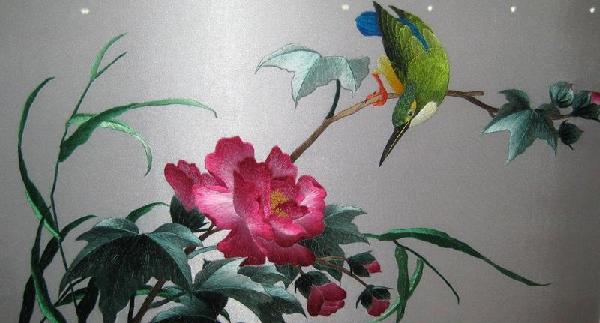Shu Embroidery

History
As early as the Western Han Dynasty (206 BC-AD 24), the poet Yang Xiong became the first to sing praises of Sichuan embroidery (Shu is the short term for Sichuan).
By the Jin Dynasty (AD 265-420), local chronicles showed that embroidery was already considered a "treasure of Sichuan".
Just like in Suzhou, amiable natural conditions were the major reason for Sichuan's booming silkworm breeding industry.
With huge productions of silk and satin, Chengdu, the capital and one of the most prosperous cities in ancient China, was the starting point of the Southern Silk Road.
The Shu Kingdom traded its embroidery for warhorses, and by the Tang Dynasty, Sichuan embroidery and its workers were the major targets of plundering when enemies invaded.
In 1903, the Qing Dynasty government established a bureau for the promotion of handwork in Chengdu, with the embroidery office as a key component. The bureau hired masters to design patterns and did considerable research on embroidering skills.
By the 1970s, the countryside of west Sichuan had as many as 5,000 embroiderers and these grassroots craftsmen produced bed linen and tablecloths, and also embroidered parlor screens for export.
Like Guangdong, Sichuan embroidery was also once known for its male needle workers, although women have largely taken over and now few men are in the trade.
Technique
Shu embroidery is typically done on the soft satin fabric produced in Sichuan province. It uses brightly colored threads, evenly stitched to produce a delicate picture or pattern. Shu embroidery is particularly characterized by the closeness of its stitching, which allows Shu embroiderers to highlight miniscule details in the subjects they produce. A Shu embroidered piece may include hundreds of thousands of stitches in a single figure or animal, and may take many days or even weeks to complete. One of the most popular subjects for Shu embroiderers is the panda bear, but scenes of nature of any kind are common. The fish which engrossed embroiderers from Sichuan in ancient times are still often seen, as are close-ups of plants, landscapes, and detailed looks at many animals.
Shu embroidery is renowned for its superb workmanship, smooth and bright in quality. It has strong expression and artistic effect. The features of it are said as "fine and smooth needlework, simple and elegant colors, graceful and easy lines and the traditional Chinese paintings' style ". Its needling characteristics lie in "the even stitches, bright threads, closeness and softness in texture, and both centrifugal and centripetal needling". The embroidery takes locally-produced colorful satin and threads as its materials.
